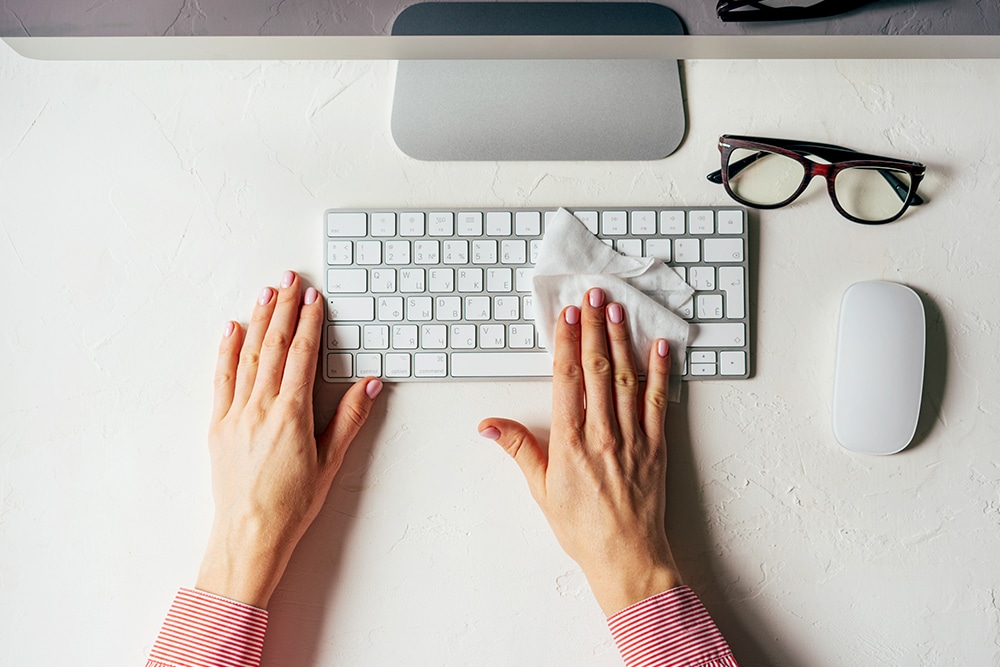Why It’s Critical To Disinfect Your Workplace
Note: As workplaces and schools re-open during the novel coronavirus pandemic and Delta variant surge, we know sanitizing and disinfecting are top of mind. There can be a lot of conflicting information out there, so make sure to use reputable sources like the Center for Disease Control and the EPA. Force of Nature is an EPA-registered disinfectant that kills 99.9% of viruses and bacteria and is on the EPA’s List N, the disinfectants approved for use against SARS-CoV-2, the cause of COVID-19. And because we get this question a lot, the EPA expects all products on List N to kill all strains and variants of SARS-CoV-2. We’re here to help – if you have questions, get in touch or find more information on our Coronavirus Resources Page.
As workplaces welcome employees and clients on-site, the way our businesses are cleaned, sanitized and disinfected has become a focus of the public’s attention. So, should you be cleaning, disinfecting or sanitizing? What exactly do those terms mean? Which should you do? And most of all – why does it matter? We’re here to answer all those questions with some background on what it means to clean, disinfect and sanitize – and why they’re a critical component to the operation of your workplace right now.
Disinfecting, Demystified (And Why It’s Critical In Your Workplace)
The Center for Disease Control (CDC) and the United States Environmental Protection Agency (EPA) provide clear definitions of cleaning, sanitizing, and disinfecting. Here’s how each of these actions work to reduce germs.
Cleaning Reduces Germs By Physically Removing Debris.
Cleaning is the important first step to reducing the number of germs on a surface. This is accomplished by physically removing liquid spills, solid debris, or residue sitting on a surface. This is important because it leaves the surface clear for sanitizing and disinfecting.
Sanitizing Reduces Germs By Killing Enough To Be “Safe.”
This term is not as specific or stringent as disinfecting. It can be accomplished by reducing the population of germs to what would be considered “safe” by public health standards. Typically you’ll see a shorter “dwell time” for sanitizing than for disinfecting, because the germ removal doesn’t have to be as thorough.
Disinfecting Reduces Germs Most Thoroughly By Killing 99.9% Of Viruses and Bacteria.
This is the big gun! Disinfectant products must be registered with the EPA, which means they go through a rigorous testing process that ensures they kill 99.9% of the microbes they say they do within a specified dwell time (usually 10 minutes). It doesn’t take 10 minutes to kill every pathogen, but because pathogens and surfaces can vary widely, most manufacturers use a 10 minute dwell time. You’ll see that 10 minutes on products using common disinfectant ingredients like quats (quaternary ammonium compounds), sodium hypochlorite (bleach) and thymol depending on their concentrations. Disinfectants should be used after a surface or object has been cleaned of any soil or residue so that it can cover 100% of the surface.
While The EPA only includes products that meet the standards as disinfectants on their List N: Disinfectants for Use Against SARS-CoV-2, they categorize both sanitizers and disinfectants as “antimicrobial pesticides.”
Why Should You Disinfect Your Workplace During COVID-19?
People are effective germ-vectors and anytime you open up your doors to let staff and clients in, you can be sure they are bringing germs, viruses, and bacteria in with them! Disinfecting with Force of Nature allows you to kill 99.9% of germs in your workplace, including resistant bacteria like MRSA & Staph and other dangerous pathogens like salmonella and listeria. Remember to always clean the surface first, before disinfecting, to maximize the efficacy of your disinfectant, and be vigilant about frequently disinfecting “high touch” surfaces (like doorknobs, faucet handles and shared technology).
How Force of Nature Can Help
While we all want to reduce our risk of spreading and contracting SARS-CoV-2, we also need to balance the negative health impact chemicals in conventional disinfectant products can have on our staff and clients. Did you know that 40% of children and 30% of adults suffer from asthma & allergies? Exposure to conventional disinfectants can carry profound health risks to your employees, colleagues and customers by triggering allergic reactions and asthma.
Force of Nature is 100% free of allergens and certified SkinSafe by the Mayo Clinic. Our active antimicrobial ingredient, hypochlorous acid, is the same substance created by our own immune systems to fight infection and is used in veterinary medicine, ophthalmic medicine, and wound care because it’s so gentle.
Additional Resources
Here are some additional resources that can help you keep your workplace disinfected and ready for business.
- Tips And Tricks For Using Force of Nature For Your Business
- How to Protect & Disinfect Your Workplace
Learn More
Ready to harness the disinfecting power of Force of Nature for your business? We’ve got all the info and shop for your starter kit today. Want to buy in bulk, or need to make enough of our formula for several bottles a day? We’ve got you covered on that too with Force of Nature Pro, our large capacity appliance that makes 32 or 64 oz of all-in-one cleaner, deodorizer and disinfectant.




